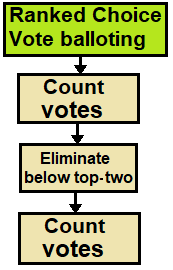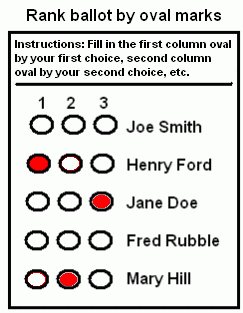Related Research Articles

The monotonicity criterion, also called positive response or positive vote weight, is a principle of social choice theory that says that increasing a candidate's ranking or rating should not cause them to lose. Positive response rules out cases where a candidate loses an election as a result of receiving too much support from voters.

Stony Plain, originally named Stonyplain, was a provincial electoral district in Alberta, Canada, mandated to return a single member to the Legislative Assembly of Alberta from 1905 to 2019. The district returned a single member to the Legislative Assembly of Alberta throughout its history, using the first past the post method of voting for most of its existence but single transferable vote from 1926 to 1957.

FairVote is a 501(c)(3) organization that researches and advocates for electoral reform in the United States.
Instant-runoff voting (IRV) is a voting method used in single-seat elections with more than two candidates. Instead of voting only for a single candidate, voters in IRV elections can rank the candidates in order of preference. Ballots are initially counted for each elector's top choice, losing candidates are eliminated, and ballots for losing candidates are redistributed until one candidate is the top remaining choice of a majority of the voters. When the field is reduced to two, it has become an "instant runoff" that allows a comparison of the top two candidates head-to-head.

The contingent vote is an electoral system used to elect a single representative in which a candidate requires a majority of votes to win. It is a form of preferential voting. The voter ranks the candidates in order of preference, and when the votes are counted, the first preference votes only are counted. If no candidate has a majority of the votes cast, then all but the two leading candidates are eliminated and the votes received by the eliminated candidates are distributed among the two remaining candidates according to voters' preferences. This ensures that one candidate achieves a majority and is declared elected.
Electoral reform in Virginia refers to efforts to change the electoral system in the Commonwealth of Virginia. Virginia has undergone much electoral change since its settling in 1607, many of which were required by federal legislation. However, it remains a relatively conservative state in this respect compared to California and others which have experimented with various alternative systems.
Electoral reform in the United States refers to efforts to change American elections and the electoral system used in the United States.

Electoral reform in California refers to efforts to change election and voting laws in the U.S. state of California.
Electoral reform in Minnesota refers to efforts to change the voting and election laws.
Electoral reform in Maryland refers to efforts, proposals and plans to change the election and voting laws in Maryland. In 2007, Maryland became the first U.S. state to join the National Popular Vote Interstate Compact. Bills have also been introduced to implement instant runoff voting (IRV) statewide, but they have failed, largely due to legislators' concerns about complicating the election process and causing technical problems similar to those encountered by Florida during the 2000 U.S. Presidential election. However, Takoma Park, Maryland adopted IRV in 2006 after it won 84% approval in an advisory ballot measure on November 8, 2005. Maryland is the home of the electoral reform organization Fairvote. In 2007, Maryland's Board of Elections Administrator, Linda Lamone, was quoted in Diebold advertising literature.
Electoral reform in North Carolina refers to efforts to change the voting and election laws in the Tar Heel State.
There have been several efforts at electoral reform in the U.S. state of Washington. In 2006, Pierce County's electorate adopted Amendment 3, voting to switch to instant-runoff voting, a voting system in which voters rank candidates in order of preference. Part of the impetus for this measure was dissatisfaction with the "pick-a-party primary" system. Washington requires 1,000 petition signatures for printed ballot access. Voting rights of felons are restored upon completion of sentence, including prison, parole, and probation. Bills to join the National Popular Vote Interstate Compact and award Washington's 11 electoral votes to the winner of the nationwide popular vote winner were introduced in both houses of the Washington State Legislature in 2007, but they died. The Bill was re-introduced in 2009, passed, and was signed into law.

Electoral reform in Colorado refers to efforts to change the voting laws in the Centennial State.

Ranked-choice voting (RCV) can refer to one of several ranked voting methods used in some cities and states in the United States. The term is not strictly defined, but most often refers to instant-runoff voting (IRV) or single transferable vote (STV).
Instant-runoff voting (IRV), also known as plurality with elimination or plurality loser, is a ranked-choice voting system that modifies plurality by repeatedly eliminating the last-place winner until only one candidate is left. In the United Kingdom, it is generally called the alternative vote (AV). In the United States, IRV is often referred to as ranked-choice voting (RCV), by way of conflation with ranked voting systems in general.

The 2009 Burlington mayoral election was held in March 2009 for the city of Burlington, Vermont. This was the second mayoral election since the city's 2005 change to instant-runoff voting (IRV), after the 2006 mayoral election. In the 2009 election, incumbent Burlington mayor won reelection as a member of the Vermont Progressive Party, defeating Kurt Wright in the final round with 48% of the vote.
Electoral reform in Oregon refers to efforts to change election and voting laws in the West Coast state of Oregon.

The term ranked voting, also known as preferential voting or ranked-choice voting, pertains to any voting system where voters indicate a rank to order candidates or options—in a sequence from first, second, third, and onwards—on their ballots. Ranked voting systems vary based on the ballot marking process, how preferences are tabulated and counted, the number of seats available for election, and whether voters are allowed to rank candidates equally.

The 2010 Oakland mayoral election was held on November 2, 2010 to elect the mayor of Oakland, California, electing Jean Quan to be their mayor. In early August 2010, incumbent mayor Ron Dellums announced that he would not be seeking reelection to a second term. In November 2010, Oakland also instant-runoff voting to elect its mayor, three city council races and four other local offices, with the elections for the mayor and Oakland council district four requiring multiple rounds of counting. Oakland used instant-runoff voting in the city's remaining elected offices in 2012. IRV was again used in 2014 and 2016, including in the 2014 mayoral election in which incumbent Jean Quan was defeated by Libby Schaaf.
References
- ↑ IRV bill headed to Senate floor, Terri Hallenbeck, Burlington Free Press, April 13th 2007.
- ↑ Overview and Summary Losing the Vote: The Impact of Felony Disenfranchisement Laws in the United States, Human Rights Watch.
- ↑ H.0373, The Vermont Legislative Bill Tracking System.
- ↑ Burlington IRV Vote, Ballot Access News, March 5, 2005 – Volume 20, Number 11.
- ↑ Gierzynski, Anthony (2011). "Special Report: Instant Runoff Voting (IRV) : Vermont Legislative Research Service Reports by Subject Area: : University of Vermont". www.uvm.edu. Archived from the original on 2012-06-08. Retrieved 2020-09-21.
- ↑ "Burlington Instant Run Off Voting Measure, (March 2010)". Ballotpedia. Retrieved 2020-09-21.